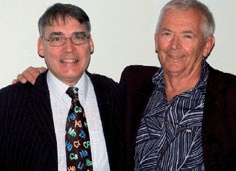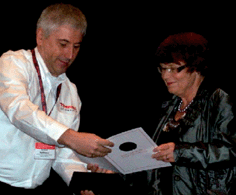Summary of the 2012 Winter Conference on Plasma Spectrochemistry January 9–14, 2012, Tucson, Arizona
Ramon M.
Barnes
University Research Institute for Analytical Chemistry, Lehigh Acres, FL 33972, USA. E-mail: wc2014@chem.umass.edu; Web: http://icinformation.org
| 1. Sample Introduction and Transport Phenomena, John Olesik, Chair |
| Recent Developments in Sample Introduction, Nicolas Bings, Johannes Gutenberg – University of Mainz |
| Analyzing Petroleum Derivatives Through ICP-AES, José Luis Todolí, University of Alicante |
| Electrothermal Vaporization Sample Introduction for Plasma Emission and Mass Spectrometry, Margaretha de Loos-Vollebregt, Delft University of Technology |
| 2. Nanomaterial Analyses and Characterization, Petra Krystek, Chair |
| Determination of Trace Elements in Airborne Nano-Particles (ANPs) and Real Time Monitoring by Direct Introduction into ICP-MS, Naoki Furuta, Chuo University |
| Liquid Chromatography and Gel Electrophoresis Coupled to ICP-MS as an Alternative Tool for the Determination of Gold and Silver Nanoparticles, Jörg Bettmer, University of Oviedo |
| 3. Laser Assisted Plasma Spectrochemistry and Laser-Induced Breakdown Spectroscopy, Gary M. Hieftje, Chair |
| Fundamental Studies on Laser-Generated and Engineered Nanoparticles by ICP-MS, Detlef Günther, ETH Zürich |
| Information Transfer Analysis of Laser-Induced Elemental Fractionation in ICP-MS, Jan Kosler, University of Bergen |
| 4. Imaging Plasma Mass Spectrometry, J. Sabine Becker, Chair, and Thermo Fisher Spectroscopy Award, Norbert Jakubowski, Chair |
| Advanced Mass Spectrometry Imaging (MSI) of Metals and Biomolecules in Brain -- BrainMet, J. Sabine Becker, Research Centre Jülich |
| Quantitative Determination and Mapping of Trace Element Concentrations in Geochemistry, Simon E. Jackson, Geological Survey of Canada |
| 5. Fundamentals, Instrumentation, and Mechanisms, David W. Koppenaal, Chair |
| Matrix Effects in Inductively Coupled Plasma Spectroscopies Revisited, Paul B. Farnsworth, Brigham Young University |
| Analyte Transport Processes: New Insight and Implications, John W. Olesik, The Ohio State University |
| 6. High-Resolution Plasma Instrumentation and Advanced Plasma Detectors, M. Bonner Denton, Chair |
| Plasma-Based Spectroscopy, M. Bonner Denton, University of Arizona |
| High Resolution Plasma Systems, David W. Koppenaal, Pacific Northwest National Laboratory |
| Advanced Optical Detection with State-of-the-Art CMOS, Gene Atlas, ImagerLabs |
| Element and Isotope Ratio Mass Spectrometry: New Capabilities with Fully Simultaneous ICP-MS, Dirk Ardelt, Spectro Analytical Instruments |
| 7. Elemental Speciation, Metallomics, Joseph A. Caruso, Chair |
| In the Search for Multiplex Absolute Concentrations and Activities Determination of Metalloproteins with ICP-MS Detection, Alfredo Sanz-Medel, University of Oviedo |
| ICP MS-Based Speciation Analyses in Answers to Regulations and Industrial Problems, Ryszard Lobinski, CNRS |
| Quantitative Peptide Analysis via Elemental Mass Spectrometry: A Focus on Hepcidin, the Key Species in Iron Homeostasis, Maria Montes-Bayón, University of Oviedo |
| 8. Plasma Source Miniaturization, Sample Introduction, and Instrumentation, Paul B. Farnsworth, Chair |
| The Microstrip Microwave Induced Plasma: A Contribution to Plasma Source Miniaturization, Klaus-Georg Reinsberg, José A.C. Broekaert, University of Hamburg |
| The Liquid Sampling – Atmospheric Pressure Glow Discharge (LS-APGD): A Practical Microplasma Alternative for Atomic Mass Spectrometry, R. Kenneth Marcus, Clemson University |
| Special Isotopic Analyses, Frank Vanhaecke, Chair |
| Challenging Isotopic and Speciation Information in Petroleum Products, Olivier Donard, IPREM |
| Implications of Mass Bias Correction in MC-ICPMS Isotope Amount Ratio Measurements, Lu Yang, Juris Meija, Institute for National Measurement Standards |
| 9. Environmental and Bioenvironmental Sciences, Michael Ketterer, Chair |
| Why Should We Care to Determine Minor and Unstable Element Species in Biological Samples? Jörg Feldmann, Eva M. Krupp, University of Aberdeen |
| Interaction Between Selenium Species and Algae – The Importance of (Speciation)2, Dirk Wallschläger, Trent University |
| 10. Stable Isotope and Forensics Analyses, Martin Resano, Chair |
| Solving Archaeological and Forensic Questions via Isotopic Analysis with Multicollector ICP-Mass Spectrometry, Frank Vanhaecke, Ghent University |
| Laser-Assisted Plasma Spectrometry in Elemental Mapping and Provenance Analysis, Viktor Kanicky, Masaryk University |
| 11. Marine and Geological Sciences, Simon Jackson, Chair |
| Hazardous Substances in the Marine Environment – From Concentrations to Biological Responses, Andreas Prange, Helmholtz-Zentrum Geesthacht |
| Geochronology Using Plasma Spectrochemistry, Mark Pecha, George Gehrels, University of Arizona |
| 12. Advanced Materials, Surface, and Interface Analyses, Norbert Jakubowski, Chair |
| Spatial and Time Resolved Measurements by a New Acousto-Optical Imaging Spectrometer in Combination with Glow Discharge Sources, Volker Hoffmann, IFW Dresden |
| Advances in Pulsed RF Glow Discharge Spectrometry, Jorge Pisonero, University of Oviedo |
| Unconventional Platforms for Plasma Spectrochemistry, Gary M. Hieftje, Indiana University |
| Laser Ablation: 50 Years New, Rick E. Russo, Lawrence Berkeley National Laboratory |
| Microfabricated Devices for Analytical and Bioanalytical Chemistry, J. Michael Ramsey, University of North Carolina |
| ICP MS and -omics: Exploring the Role of Elements in the Chemistry of Life, Joanna Szpunar, LCABIE |
| The Role of Modern Plasma-Based Spectroscopies in the Material Sciences, Norbert Jakubowski, BAM |
| 2012 Heritage Lectures |
| The Paradigm Change of the Instrumental Revolution. Professor Leo de Galan, Schiedam, The Netherlands |
| Scientific Research: Creativity and Discovery. Professor Chris Enke, University of New Mexico |
| Paradigm Shifts in Analytical Plasma Spectrometry. Professor Gary Horlick, University of Alberta |
| Inductively Coupled Plasma Mass Spectrometry: A Personal Odyssey, Trials, Tribulations, Problems, and Successes. Professor Henry Longerich, Memorial University of Newfoundland |
| Flow Injection Analysis – From Beaker to Microfluidics. Professor Jaromir (Jarda) Ruzicka, University of Hawaii, Manoa |
| Spectrochromatography Elemental Speciation, Retrospect, Perspective and Prospects. Professor Peter C. Uden, University of Massachusetts |
| 2010 Heritage Lectures |
| Thirty-Seven Years of Plasma Spectrochemistry at FDA's Elemental Analysis Research/Forensic Chemistry Center, Fred L. Fricke, US Food and Drug Administration |
| Isotope Ratio Measurements: Highlights, Pitfalls, Frustrations—40 Years of Experience in the Field, Professor Klaus G. Heumann, Johannes Gutenberg – University Mainz |
| The Glow Discharge: A Splendidly Versatile Source, Professor Willard W. Harrison, University of Florida |
| From Academic Research to Real World Problems (and vice versa), Jean-Michel Mermet, Spectroscopy Forever, Tramoyes, France |
| Some Memories of 20 Years Development and Application of ICP Emission Spectrometry, Professor Knut D. Ohls, SPETEC, Erding, Germany |
| Over 50 Years of Atomic Spectroscopy, Professor James D. Winefordner, University of Florida |
With the increasing use of nanomaterials in process materials, consumer products, food and medicine, a symposium on “Nanomaterial Analysis and Characterization” was added to the traditional program and was one of the longest sessions with 11 lectures and nine poster presentations covering subjects from fundamental detection methods to a variety of applications according to chairperson Petra Krystek, who also presented a short course on nanomaterial characterization.
After his plenary lecture Gary Hieftje chaired the session on Laser-Assisted Plasma Spectrochemistry and LIBS and introduced his former student Rick Russo as the plenary speaker. Russo gave a historical review of the evolution of laser ablation and LIBS and discussed frontiers such as measurement of nanoscopic regions of a sample by means of either laser ablation ICP-MS or LIBS. Russo showed that current ICP-MS sensitivities are not yet up to the task of such measurements, however. Hieftje commented: “… both laser ablation and LIBS have moved into the realm of routine, robust tools for elemental and molecular analysis, and that new uses and approaches continue to be introduced.”
Owing to increasing importance of a new area of research in life sciences, Imaging Plasma Mass Spectrometry, which can determine the elemental distribution in biological tissue, also was recently introduced as a hot topic at the Winter Conference. A special symposium featured the second Thermo Fisher Spectroscopy Award, which was presented to J. Sabine Becker for outstanding developments in imaging ICP-MS. Becker summarized the symposium: “…plasma spectrochemistry imaging has been pushed in different laboratories worldwide for elemental distribution analysis and is developing straightforward[ly] as a very important analytical tool with major application fields in life sciences.” By the way, nominations for the 2014 award are now being solicited.
Novel plasma instrumentation was featured in three symposia, poster sessions, and a workshop, where basic research, development, and applications were explored. For example, glow and atmospheric pressure discharges were featured in the final symposium, and high-resolution spectrometers and advanced detection systems were presented in a symposium arranged by Bonner Denton.
During the symposium on Fundamentals, Instrumentation, and Mechanisms, Michael Ramsey gave a very inspiring plenary lecture that discussed recent advances in the development and use of microfabricated fluidic devices and instrumentation including micro-sized mass spectrometers and peptide and DNA sequencing approaches using microfluidic channels and electrochemical detection. David Koppenaal, who chaired the symposium, observed: “Overall the session was very stimulating, with both fundamentals and new developments described, and the audience found the mid-week morning passing all too quickly!”
The session on Plasma Source Miniaturization focused on alternative plasmas for use as both ionization and emission sources. According to chairman Paul Farnsworth, “…despite the gradual evolution over the years of compact solid-state sources and advances in electronic control, ICP's are expensive to build and operate, and their size, power demands, and high rates of gas consumption preclude their incorporation into portable instruments.” He concluded, “None of the presenters claimed to have developed a universal replacement for the ICP, but it is clear that for some applications, smaller, less expensive plasmas may be viable alternatives to the ICP.”
The concluding three conference days included many excellent presentations on developments in advanced materials, forensic, isotopic, and speciation analyses, as well as environmental, geochemical, and marine sciences. According to Simon Jackson, who chaired the Saturday morning session, “…fully 50% of the geoscience presentations described LA-ICP-MS techniques, attesting to the ever-growing recognition of the enormous power of this technique for in situ elemental and isotopic analysis of solid samples.” Without much doubt high-resolution and/or commercial multicollector ICP-MS instruments and laser ablation techniques have provided revolutionary progress in many application areas, especially geosciences, stable isotope forensics (e.g., to attain provenance information for some relatively uncommon non-radiogenic systems), and elemental speciation. However, Norbert Jakubowski, chairman of the Advanced Materials, Surface, and Interface Analyses symposium pointed out: “…switchable resolution with no loss in sensitivity is urgently needed for the next generation of plasma based mass spectrometers.”
New commercial plasma systems also were introduced during the conference including an ICP triple quad mass spectrometer (Agilent), a microwave plasma atomic emission spectrometer (Agilent), a laser ablation ICPMS (LA-MC-ICP-MS) system (Thermo Fisher Scientific), and a piezoelectrically activated nebulizer (Perkin Elmer). According to Gary Myers, who chaired the workshop on new plasma instrumentation, “this session… had something for everyone and included particular treats from vendors who featured their newly unveiled instruments.”
With new and improved plasma sources, photon and ion analyzers, and detector instrument developments described during the conference combined with progress in sample preparation and sample introduction systems, plasma spectrochemistry will continue as the major resource for elemental, isotopic, and speciation analyses in the foreseeable future. Thus, the Winter Conference program will continue with meetings in Jeju Island, Korea (August 2012), Krakow, Poland (February 2013), Amelia Island, Florida (January 2014), and Tucson, Arizona (January 2016).
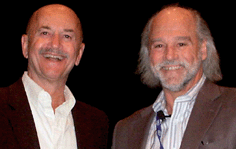 Gary Hieftje and Rick Russo
Gary Hieftje and Rick Russo
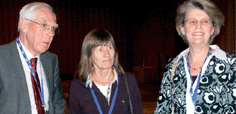 Leo de Galan, Greet de Loos-Vollebregt, Elisabeth Jensen
Leo de Galan, Greet de Loos-Vollebregt, Elisabeth Jensen
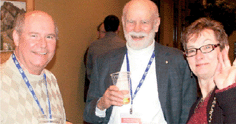 Gary Horlick, Henry Longerich and Maureen Horlick
Gary Horlick, Henry Longerich and Maureen Horlick
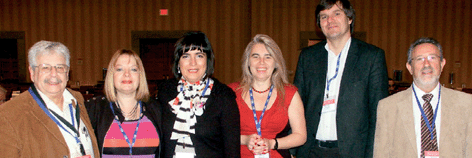 Joseph Caruso, Patricia Smichowski, Maria Montes-Bayón, Joanna Szpunar, Ryszard Lobinski, and Alfredo Sanz-Medel
Joseph Caruso, Patricia Smichowski, Maria Montes-Bayón, Joanna Szpunar, Ryszard Lobinski, and Alfredo Sanz-Medel
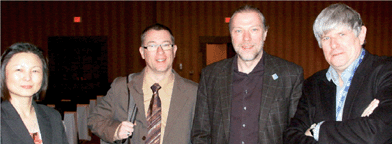 Lu Yang, Frank Vanhaecke, Jörg Feldmann, and Olivier Donard
Lu Yang, Frank Vanhaecke, Jörg Feldmann, and Olivier Donard
References
- ICP Inf. Newsl., 37(09), 1365–1589, ( February 2012) Search PubMed.
| This journal is © The Royal Society of Chemistry 2012 |

